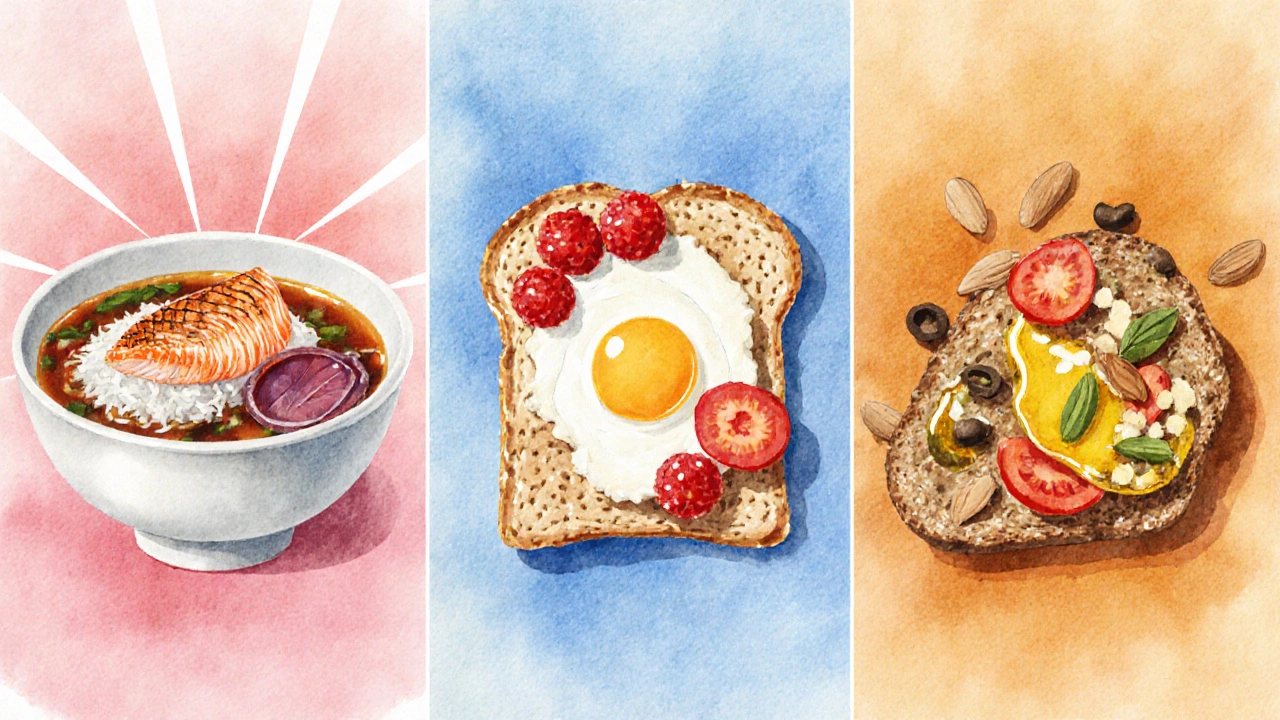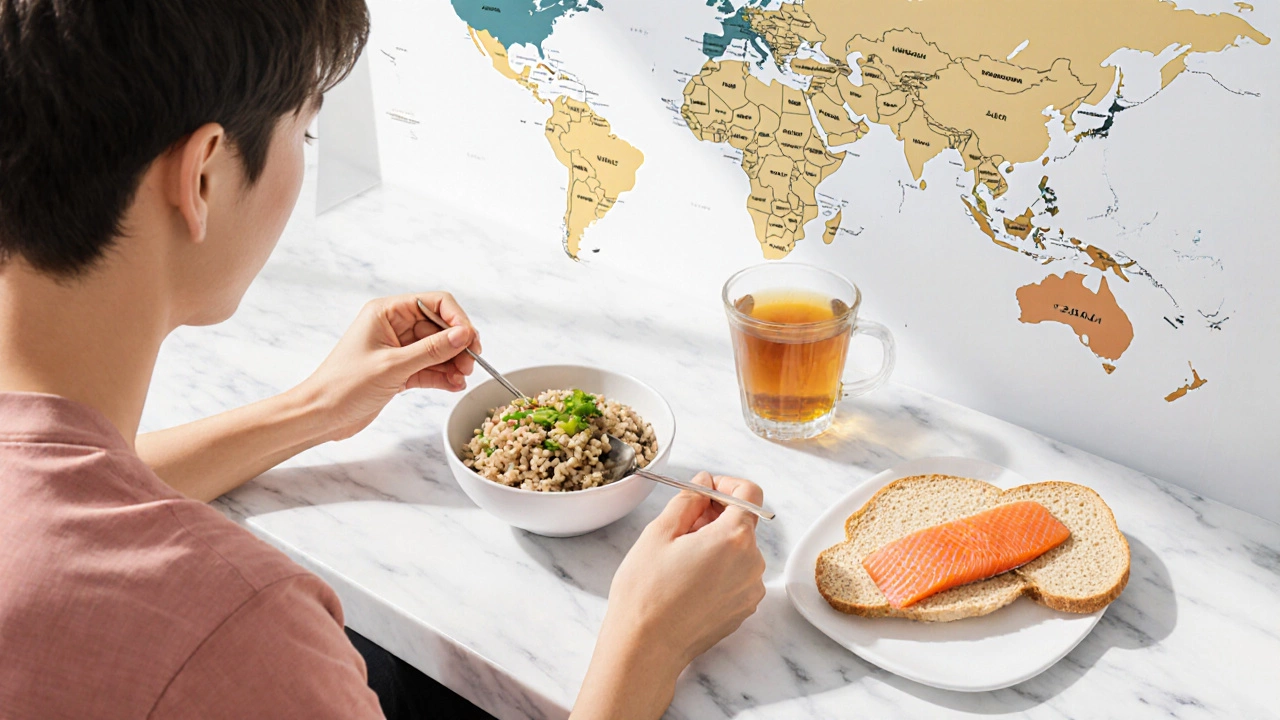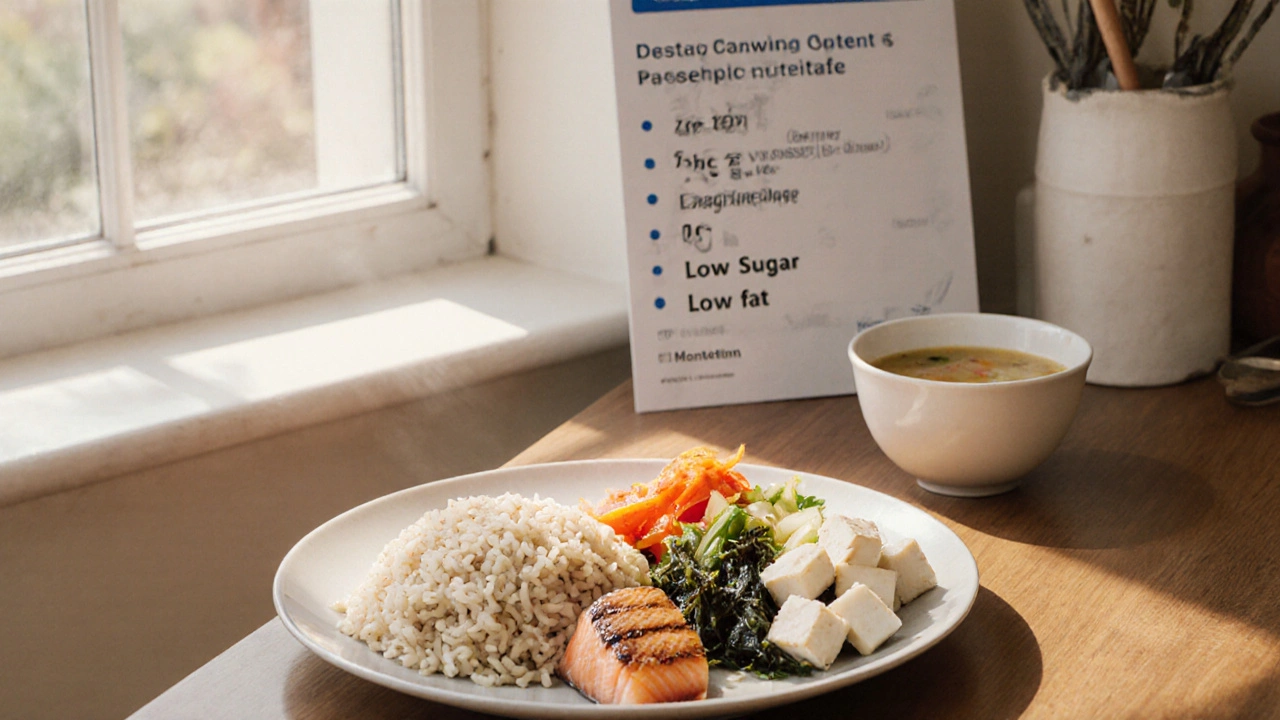Breakfast Nutrition Comparison Tool
Japan
Nutrient-dense, low-sugar
Sweden
High-protein, low-sugar
Mediterranean
Heart-healthy, colorful
Nutritional Profile
Key Benefits
Macronutrient Breakdown
Ever wondered which nation actually starts the day on the right foot? This article breaks down the data, highlights the foods that make a breakfast truly nutritious, and shows how you can borrow a few ideas for a healthier morning routine.
What counts as a healthy breakfast?
Healthy breakfast is a morning meal that provides a balanced mix of carbohydrates, protein, fiber, vitamins and minerals while keeping added sugars and saturated fats low. Health agencies such as the World Health Organization sets global dietary recommendations to curb chronic disease suggest that a good breakfast should cover about 20‑25% of daily calories, include at least 5‑7 grams of fibre, and feature whole‑grain carbs plus a lean protein source.
Key metrics used to judge breakfast quality include total calories, macronutrient ratio (carbs‑protein‑fat), fibre content, sugar level, and micronutrient density (iron, calcium, vitaminC, etc.). The glycemic index ranks carbs by how quickly they raise blood glucose also matters because low‑GI foods keep energy stable until lunch.
Top contenders: Nations with the healthiest morning plates
Researchers from the International Food Policy Centre analysed breakfast surveys from 15 countries, applying the WHO criteria mentioned above. Three countries consistently topped the rankings:
- Japan has a culture of small, nutrient‑dense meals featuring rice, fish, soy and seasonal vegetables
- Sweden offers whole‑grain breads, berries, low‑fat dairy and boiled eggs, creating a low‑sugar, high‑protein start
- Mediterranean diet regions such as Italy and Greece rely on olive oil, nuts, fruits and whole‑grain breads for a heart‑healthy breakfast
Below, we dive into why these diets score so well.
Why Japan’s breakfast is a nutritional powerhouse
Typical Japanese breakfast includes steamed rice, miso soup, grilled fish (often salmon or mackerel), a side of natto or tofu, and pickled vegetables. Here’s how it stacks up:
- Calories: ~350kcal, fitting the 20‑25% daily target for an average 1,800‑2,000kcal diet.
- Macronutrients: 50% carbs (mostly low‑GI rice), 25% protein (fish, soy), 25% fat (healthy omega‑3s from fish).
- Fiber: 6‑8g from pickles and seaweed, meeting half the daily recommendation.
- Micronutrients: High in iodine, vitaminD, B‑vitamins, and calcium.
Portion control is built into the culture-rice bowls are modest, and the meal is spread over 20‑30minutes, which helps regulate blood sugar.

Swedish breakfast: Simple, high‑protein, low‑sugar
A classic Swedish plate consists of whole‑grain crispbread (knäckebröd), low‑fat cottage cheese or Skyr, a boiled egg, and a handful of fresh berries. Sometimes a glass of oat milk is added.
- Calories: ~370kcal, aligning with WHO energy recommendations.
- Macros: 45% carbs (high‑fiber crispbread), 30% protein (cottage cheese, egg), 25% fat (mostly unsaturated from dairy).
- Fiber: 7‑9g, thanks to whole‑grain crispbread and berries.
- Sugar: Under 5g, well below the 10% of total calories limit.
The focus on dairy provides calcium and vitaminD, while berries add antioxidants and vitaminC.
Mediterranean morning meals: Heart‑friendly and colorful
In Italy or Greece, breakfast might be a slice of whole‑grain toast drizzled with extra‑virgin olive oil, topped with sliced tomatoes, olives, and a few almonds. A cup of herbal tea or black coffee completes the spread.
- Calories: 300‑350kcal, modest but nutrient‑dense.
- Macros: 40% carbs (whole‑grain bread), 30% healthy fats (olive oil, nuts), 30% protein (cheese, nuts).
- Fiber: 5‑7g from whole wheat and vegetables.
- Key nutrients: Monounsaturated fats (olive oil) lower LDL cholesterol; antioxidants from tomatoes and olives support vascular health.
The Mediterranean approach embraces variety, seasonal produce, and minimal processing, which keeps added sugars and sodium low.
How other countries compare
| Country | Avg. Calories | Carb% (GI<55) | Protein% (g) | Fiber(g) | Typical Foods |
|---|---|---|---|---|---|
| Japan | 350 | 50 | 25 | 6‑8 | Rice, grilled fish, miso soup, natto, pickles |
| Sweden | 370 | 45 | 30 | 7‑9 | Whole‑grain crispbread, cottage cheese, boiled egg, berries |
| Italy (Mediterranean) | 330 | 40 | 30 | 5‑7 | Whole‑grain toast, olive oil, tomatoes, olives, nuts |
| United States | 440 | 55 | 20 | 3‑4 | Cereal with milk, pastries, bacon, orange juice |
| Australia | 410 | 52 | 22 | 4‑5 | Toast with Vegemite, eggs, fruit smoothies |
Notice how the top three nations keep calories moderate, carbs low‑GI, protein decent, and fibre above five grams. In contrast, the United States and Australia often exceed the sugar and calorie thresholds.

Practical takeaways for your own breakfast
- Portion control: Aim for 300‑400kcal; use a kitchen scale or visual cues (a fist = carbs, palm = protein).
- Low‑GI carbs: Swap white toast for whole‑grain rye or sprouted bread; try a small bowl of oatmeal topped with berries.
- Protein boost: Include fish, eggs, Greek yoghurt, tofu, or a handful of nuts.
- Fiber focus: Add a piece of fruit, a side of vegetables, or a tablespoon of chia seeds.
- Healthy fats: Drizzle olive oil, sprinkle seeds, or use avocado instead of butter.
Mix and match elements from the three leading countries. For example, a Japanese‑style miso soup paired with Swedish crispbread can give you both umami flavor and crunch, while a splash of olive oil adds heart‑friendly fats.
Common pitfalls and how to avoid them
Many people assume a “healthy” breakfast means low calories only. In reality, skipping protein or fibre leads to mid‑morning cravings and spikes in blood sugar. Also, beware of “granola” marketed as wholesome-some varieties contain added honey or oil that push sugar and calorie counts higher.
Another mistake is over‑relying on sugary beverages. A glass of orange juice may seem nutritious, but it can add 20‑30g of sugar. Opt for water, herbal tea, or a small serving of kefir instead.
What the future holds for global breakfast trends
Food tech is introducing plant‑based proteins that mimic fish texture, making it easier for Westerners to adopt Japanese‑style breakfasts without seafood. Meanwhile, Nordic countries are promoting “food as medicine” campaigns that emphasize whole‑grain and fermented foods, likely tightening Sweden’s lead.
Governments are also updating school meal guidelines. In 2024, the European Union mandated that 30% of school breakfast calories come from whole grains-a move that could shift national averages toward healthier patterns over the next decade.
Frequently Asked Questions
Which country has the lowest‑calorie breakfast?
Japan’s traditional breakfast averages about 350kcal, which is slightly lower than Sweden’s 370kcal and the Mediterranean 330‑350kcal range.
Can I get a healthy breakfast on a tight budget?
Yes. Focus on inexpensive staples like oats, beans, seasonal fruit, and bulk whole‑grain bread. Adding a boiled egg or a spoonful of peanut butter supplies protein without breaking the bank.
How important is the glycemic index for breakfast foods?
Low‑GI carbs release glucose slowly, preventing energy crashes and keeping you full until lunch. Aim for foods with GI below 55, such as steel‑cut oats, whole‑grain rye, or sweet potatoes.
Are smoothies a healthy breakfast choice?
Smoothies can be healthy if you use whole fruits, leafy greens, a protein source (Greek yoghurt, tofu, or protein powder), and a low‑sugar liquid base. Avoid adding extra honey or flavored syrups.
What’s a quick breakfast that mimics Japan’s protein profile?
Try a bowl of instant brown rice topped with canned salmon, a side of miso soup (made from powder), and a few slices of pickled cucumber. It takes less than 10 minutes and hits the protein‑carb‑fat balance.
